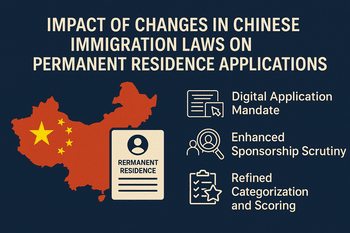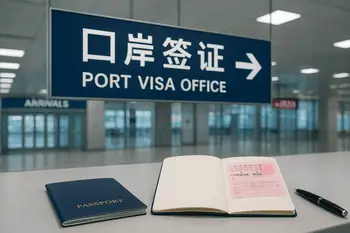
China’s immigration landscape is evolving rapidly. Recent reforms aim to streamline processes, enhance digital integration, and tighten sponsorship scrutiny.
For expats and investors aspiring to obtain permanent residence, these changes are as promising as they are challenging.
In this blog post, we unpack the recent legal shifts and their direct impact on permanent residence applications, offering insight into how you can best navigate this evolving system.
A New Era for Chinese Immigration
Over the past few years—and especially with the reforms rolled out in 2025—China has introduced a series of changes to its immigration and work visa system.
Notably, the centralized digital application mandate has expedited administrative processing, replacing many previously paper-based procedures.
For instance, recent policy updates now require that all work visa submissions, and by extension parts of the permanent residence application process, be handled digitally, ensuring speed and efficiency but simultaneously raising the bar for document precision and applicant preparedness.
These changes reflect China’s broader strategy of promoting high-skilled foreign talent while ensuring that employers and sponsoring companies adhere to stricter verification standards.
As a result, both individual applicants and corporate sponsors must update their documentation practices and internal procedures.
The introduction of grace periods and refined scoring categories helps align China’s immigration system with international norms, yet applicants may still face new hurdles if they are unprepared for the digital transition.
Understanding the New Requirements
Before applying for permanent residence, it’s crucial to understand the revamped permanent residence criteria.
Authorities now assess eligibility in several defined categories—ranging from high-level experts to significant investors, as well as provisions for family reunions.
According to official guidelines provided by the Beijing government and the National Immigration Administration, applicants must not only demonstrate professional or economic contributions but also comply with enhanced requirements of stability and financial accountability.
For example, expats in senior positions or those with notable investments now face stricter thresholds.
The process may include demands for detailed tax records, precise employment history, and concrete evidence of contributions to China’s economy or society.
This meticulous approach ensures that permanent residence is granted only to those who meet clearly defined standards, leaving little room for ambiguity.
Impact on Permanent Residence Applications
The evolving immigration laws have a direct, multifaceted impact on permanent residence applications:
- Digital Application Mandate
The shift to a centralized digital platform streamlines the overall process. While it eliminates much of the manual paperwork and reduces administrative delays, it does require applicants to be digitally savvy and thoroughly prepared with electronic copies of all documentation. Inaccuracies or omissions can lead to immediate rejection, making precision paramount. - Enhanced Sponsorship Scrutiny
Companies now face increased responsibilities. They must provide additional evidence regarding labor market shortages, business licenses, and detailed employment justifications when sponsoring foreign talent. This means that applicants tied to corporate sponsorship must ensure that their employers are equally diligent in maintaining accurate and comprehensive records. - Refined Categorization and Scoring
The new points-based system classifies foreign talent into three categories (A, B, and C), with explicit thresholds that determine eligibility. High-level talent (Category A) not only faces higher salary and experience requirements but also benefits from quicker processing. In contrast, lower-category applicants might find the bar raised significantly, thereby reducing the overall approval rate for many. - Grace Period Extensions
One of the more applicant-friendly reforms is the introduction of a grace period that allows expats to remain in China for up to 60–90 days after employment termination. This period provides much-needed time for job searches or visa transitions. However, the grace period is not automatic and requires proper application—underscoring that every step must still be carefully managed.
A Comparative Look: Old vs. New Processes
Below is a table that encapsulates the key differences between the old and new immigration procedures, shedding light on how each change impacts the permanent residence application process:
| Category | Previous Process | New Process (2025 Update) | Impact on Applicants |
|---|---|---|---|
| Application Method | Mix of paper and digital submissions | Fully centralized digital application system | Faster processing; increased need for digital literacy and precision |
| Sponsorship | Moderate documentation requirements | Stricter scrutiny with detailed labor market and business documentation | Employers must upgrade their processes; higher validation standards |
| Grace Period | Immediate exit required upon employment end | Up to 60–90-day grace period for transition after job termination | Provides extra time for transitions; demands timely and formal requests |
| Qualification Criteria | Looser guidelines on experience and investment | Clearly defined scoring system (Categories A, B, and C) with specific thresholds | Greater transparency, but higher standards for lower-category applicants |
| Investment & Tax Records | Variable requirements depending on the region | Increased threshold for investment plus mandatory three-year tax record history | Better opportunities for high-quality investors; tougher for casual investors |
Table 1: Comparison of Immigration Processes Before and After the 2025 Reforms
These streamlined measures are designed to create a fair, transparent, and efficient system.
Yet, they simultaneously require a recalibration of how applicants prepare their documentation and meet the new eligibility demands.
Opportunities and Challenges for Expats
While the changes bring clarity and efficiency, they also pose distinct challenges:
- Opportunities:
The digital transformation reduces the processing time, making it possible for qualified applicants to receive decisions faster. High-skilled individuals and those in managerial or investment roles now have an opportunity to benefit from the clear categorization and defined requirements. Furthermore, the grace period extension provides a critical buffer during periods of transition, easing the stress of sudden job loss or career changes. - Challenges:
The increased demands for documentation mean that even small errors or omissions can derail an application. Companies and candidates alike must invest extra time in ensuring compliance with the digital system’s requirements. This means staying informed about the latest policy updates, often through trusted external sources like the Beijing Permanent Residence Official Guidelines and NIA guidelines.
Understanding these dual aspects is essential for any applicant.
Whether you’re an individual taxpayer, an investor, or a corporate sponsor, the key to success lies in detailed preparation and ongoing education regarding policy nuances.
Regional Variations: A Closer Look
Regional differences in application criteria also play a significant role.
In metropolitan areas like Beijing, immigration authorities tend to emphasize contributions to economic and social development.
Applicants in these cities face a rigorous evaluation process but also have access to more streamlined benefits and clearer guidance for permanent residence.
Conversely, other cities may implement slightly adjusted requirements based on local labor market conditions and economic priorities.
The following table offers a snapshot of how eligibility might vary:
| Region | Focus Area | Eligibility Highlights | Implications |
|---|---|---|---|
| Beijing | Economic and social contributions | Emphasis on long-term employment, tax records, and high-level talent designation | Detailed guidelines and a rigorous evaluation process |
| Shanghai | Integration of digital platforms | Strong push for workspace digitalization and clearer sponsorship documentation | Faster digital processing with strict documentation accuracy |
| Guangzhou | Investment and business development | Higher thresholds for job titles and investment records | Favorable for high investments; challenging for lower-tier applicants |
Table 2: Regional Differences in Permanent Residence Eligibility
These variations underscore the importance of tailoring your application to not only the national guidelines but also the local requirements of the area in which you reside or wish to settle.
Best Practices for Navigating the New Regulations
Given the rapid evolution of China’s immigration policies, both applicants and corporate sponsors should consider the following best practices:
- Stay Updated:
Immigration policies continue to evolve. Regularly check reputable sources such as official government websites and expert analysis platforms. For instance, the HROne blog is an excellent resource for staying abreast of the latest visa innovations and policy changes. - Invest in Digital Competence:
With the move to fully digital applications, ensure that you have high-quality, scanned copies of all required documents. Consider digital storage solutions and backup systems to avoid any loss of paperwork. - Engage Professional Support:
Given the complexity of the new measures, it may be wise to consult immigration lawyers or professional visa service providers. Their expertise can help ensure that your application meets all the updated criteria and is submitted correctly. - Collaborate with Employers:
If you’re an expat sponsored by your employer, confirm that they are updated on the latest rules. A proactive employer can assist with getting the necessary evidence on labor market conditions and company documentation. - Plan for Contingencies:
The extended grace period is a positive step, but it still requires formal application. Make sure you understand the process and deadlines for transitioning between different visa types or securing an extension, if needed.
Conclusion
The sweeping changes in Chinese immigration laws represent both an opportunity and a challenge for those seeking permanent residence.
By embracing digital applications, meeting higher standards of documentation, and understanding regional differences, applicants can better navigate the complex landscape and improve their chances of success.
These reforms—designed to attract top talent and ensure robust economic contributions—demand thorough preparation and proactive strategy.
Whether you’re a high-level investor, a skilled professional, or an expat planning for long-term residence, staying informed and prepared is your best asset in the changing world of Chinese immigration.
For further reading on detailed eligibility criteria and up-to-date guidelines, check out the following official resources:


